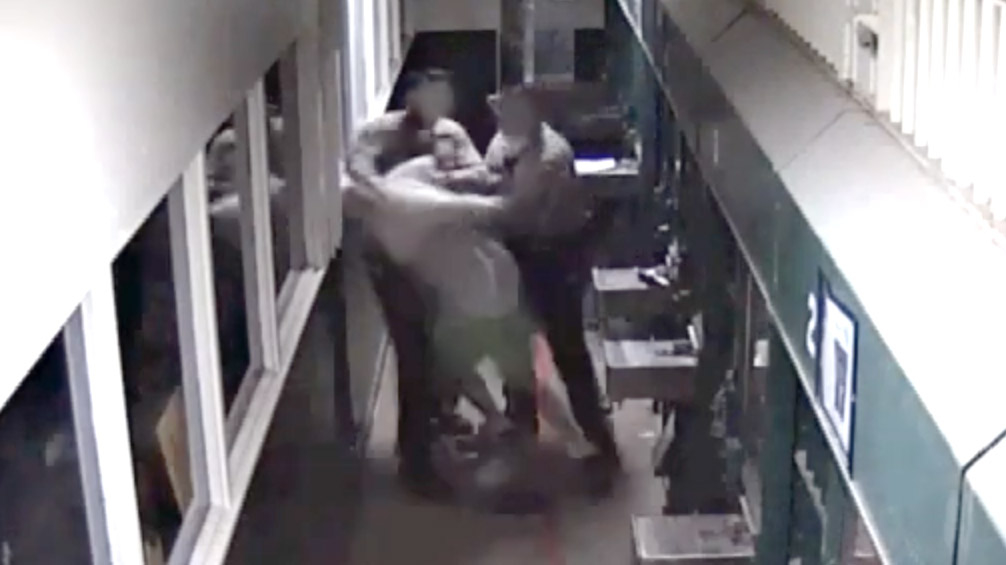
Videos unsealed this week from the Los Angeles County jail system show deputies beating inmates and using excessive force, suggesting the Sheriff’s Department has been slow to reform its practices under an agreement with the ACLU.
Sheriff’s officials, however, say the security recordings taken during a previous administration are not representative of the department’s interactions with inmates and do not reflect the changes made under current Sheriff Robert Luna.
The videos, spanning a time frame from October 2019 to July 2022, were released late Thursday, Nov. 9, by U.S. District Court Judge Dean Pregerson as part of a lawsuit brought by Alex Rosas and the American Civil Liberties Union against the Sheriff’s Department over the treatment of inmates in the jail system. Los Angeles Times Communications and WitnessLA had requested the videos be unsealed.
RELATED: See more of the unsealed videos here.
“In the 11 years since this case was instituted, there has been a complete cultural shift away from the days when such abuses were tolerated, and Sheriff Luna is intent on building on that progress comprehensively, and at a more rapid pace than his predecessors,” the Sheriff’s Department said in a statement on its website.
The videos, gritty and troubling, show deputies controlling inmates with punches to the head, the use of a questionable restraining device and a knee on the neck. The ACLU and the Sheriff’s Department are continuing to refine a 2014 agreement to reduce the use of head strikes as well as a controversial restraining device known as the body WRAP.
‘Unnecessary and dangerous’
Peter Eliasberg, an ACLU attorney, said the department has a ways to go toward fulfilling its commitment.
“Deputies continue to punch people who are incarcerated in the head during force incidents when this dangerous tactic is unnecessary and dangerous,” Eliasberg said. “Worse still, supervisors approve these out-of-policy head punches as permissible even though year after year the federal court monitors … conclude that the department far too often signs off on head strikes that are clearly out of policy.”
He added, “As long as deputies think, ‘We can do this stuff and nothing is going to happen,’ it will continue.”
Head strikes a concern
Court monitors, in a recent report, said they disagreed with 85% of the head strikes that department supervisors concluded were justified.
Head blows can cause brain hemorrhaging, facial fractures and eye injuries. Additionally, they can exacerbate mental illnesses suffered by many jail inmates, the ACLU has said, noting that 41% of inmates have serious mental illnesses.
In one video, two deputies can be seen bashing an inmate’s head against a window while escorting him down a jail corridor. The inmate’s hands are behind his back. The video is time-stamped July 2022, when Alex Villanueva was sheriff.
“That’s totally brutal, totally uncalled for and very, very dangerous,” Eliasberg said. “There is just no justification for it.”
The Sheriff’s Department has referred that incident to the Los Angeles County District Attorney’s Office for potential prosecution.
In another video, a deputy can be seen pushing an inmate against a jail cell and then repeatedly punching him in the head. The inmate apparently had asked for soap and complained when he didn’t get it, Eliasberg said.
“Even when force is necessary, the force should be proportional to the situation. It almost never should be a head punch,” he said.
Sheriff’s officials countered that the use of head strikes at the county’s nine jails has fallen dramatically over the past two years and are on pace to hit only 48 in 2023, the lowest of any year since the lawsuit was filed in 2012. The department estimated that up to 60,000 inmates pass through the system in any given year.
The department’s existing policy says head strikes can be used only when an inmate is assaulting a deputy or when a deputy is threatened with serious injury and there is no other means for control.
Deputies will be held accountable
“Sheriff Luna has set a new tone when it has come to making it clear that, regardless of this dramatic drop in uses of force involving inmates, when deputies engage in uses of force in a manner that violates the department’s strict use of force policies, they will be held accountable,” said the department’s website.
In one video, a deputy places a knee on the neck of an inmate who has been taken to the ground, reminiscent of the police tactic that killed George Floyd in Minneapolis in 2020. In the Los Angeles County incident, the knee remains in place for less than a minute, compared to the more than nine minutes for Floyd. Eliasberg said the deputy in this case was disciplined.
Another video shows deputies employing the controversial WRAP device, which encircles an inmate’s legs and connects to a chest harness. Doctors say the device can lead to positional asphyxiation, which is putting the inmate in a physical position that restricts breathing.
Many California law enforcement agencies have paid heavily to settle wrongful death cases involving the WRAP, including Pleasanton ($5.9 million), Alameda County ($2.7 million), Hayward (three cases totaling $2.4 million), San Diego County ($1.35 million) and National City ($300,000).
The Sheriff’s Department placed the jail videos on its official website as a show of transparency and said it welcomes more discussions with the court and the ACLU.
“The Sheriff’s Department will continue to have an open dialogue with the ACLU and the court-appointed monitors in this case to explore ways to improve the Department’s performance and will continue to be forthcoming in its efforts to ensure an honest analysis of every use of force incident that occurs,” said the site.
